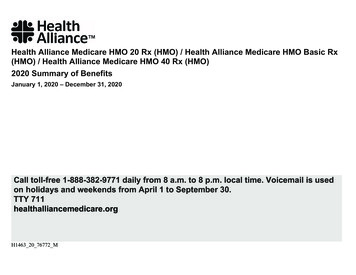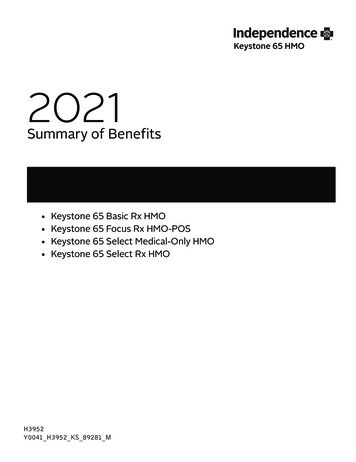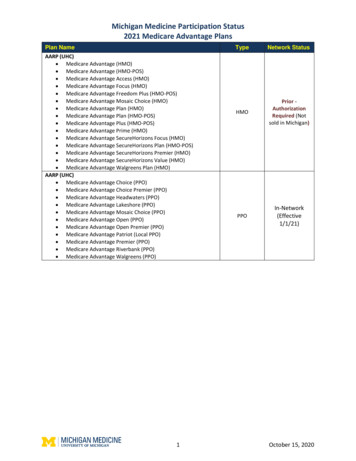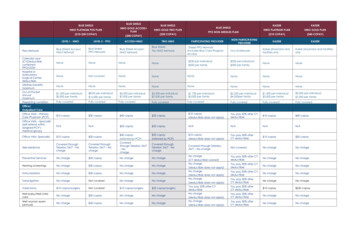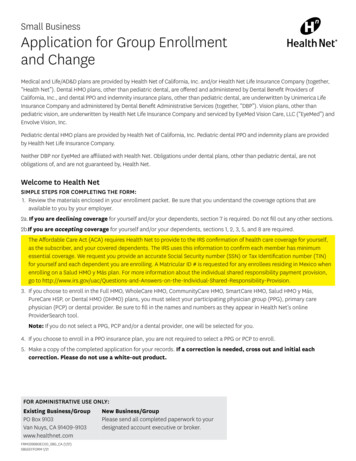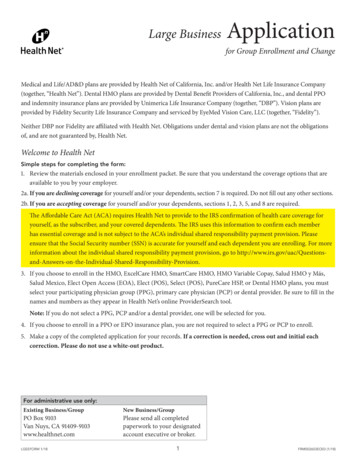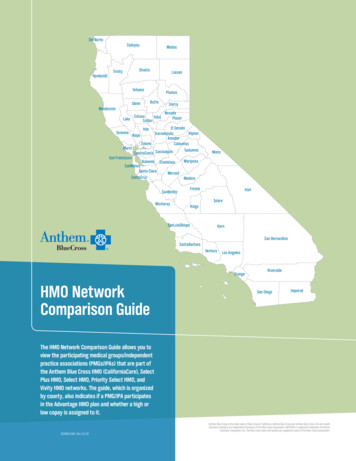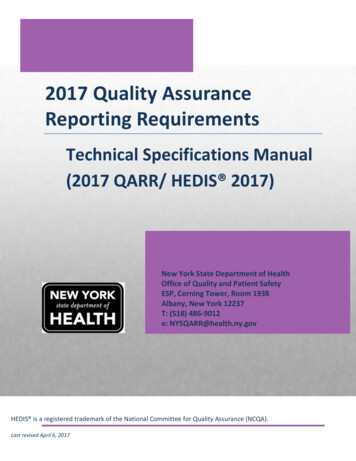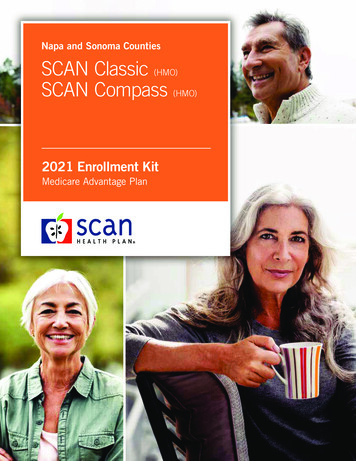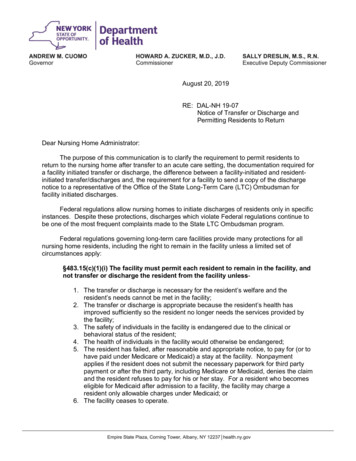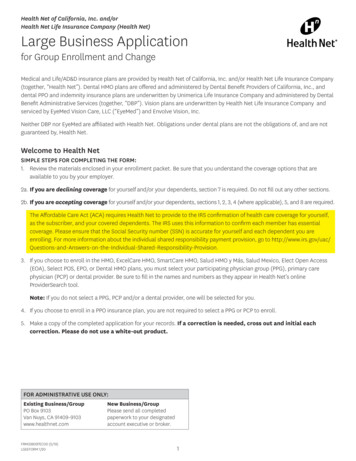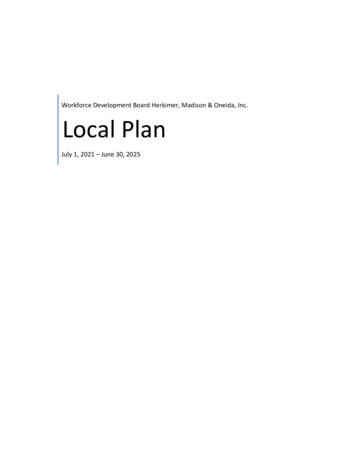
Transcription
Workforce Development Board Herkimer, Madison & Oneida, Inc.Local PlanJuly 1, 2021 – June 30, 2025
Table of ContentsTable of Contents . 1Strategic Planning Elements . 2Local Workforce Development System . 8Workforce Development and Career Pathways. 10Access to Employment and Services. 11Business Engagement. 13Program Coordination. 14Title II Program Coordination . 15Youth Activities . 16Administration. 18Training Services. 19Public Comment . 20List of Attachments . 201Local Plan Template
Strategic Planning ElementsLocal Workforce Development Areas (LWDAs) and Regional Demand Lists are now maintained online.Changes to the Demand Lists can be made by following the directions on the webpage.I attest that the priority ranked list of the LWDA’s demand occupations was last updated on [specifydate in the text box below].May 14, 2021How is this information shared with the Local Workforce Development Board (LWDB)? What was thelast date on which it was shared?Information is shared with the board during regular board meetings. The last date onwhich it was shared was May 14, 2021.a. Provide an analysis of regional economic conditions, including:i.Existing and emerging in-demand sectors and occupations; andAccording to the Workforce Development Board Herkimer, Madison & Oneida Counties,Inc. Strategic Action Plan 2020-2022, existing in-demand sectors for the region includehealthcare, education services, manufacturing, social assistance, and hospitality and foodservices. As for emerging in-demand sectors, they include call centers, and CREE high techadvanced manufacturing.ii. The employment needs of businesses in those sectors and occupations.Some of the top issues identified by employers in the HMO Strategic Action Plan were:- Pool of skilled workfroce at all levels due to agine of the population and a shrinking laborforce.- High level of competition for skilled workers.-Lack of soft sills, work ethic and technical skills to meet current need.-Demand for higher saleries due to the high rate of competition for skiled workers.Inadequate public transportation and childcare services for workers.b. Describe the knowledge, skills, and abilities needed to meet the employment needs of businesses,including those in in-demand sectors and employing individuals in demand occupations.Across the board employers are reporting that the greatest weakness, beyond the lack ofaccess to a large and diverse local talent pool, is that current applicants lack soft skills and2Local Plan Template
work ethic, have unrealistic expectations for the job including wages and hours, and lacktechnical skills including basic computer, math, and reading skills.Additionally, some chronic issues that were found is that employers are challenged withtheir ability to fill new jobs as well as replace existing vacant positions due to agingworkers and an overall shrinking labor force. There is an anticipated need to fill 156,833jobs overall in the next 10 years resulting from a combination of retirements and newlycreated positions. Attracting workers to jobs where the wages are not competitive withother regions in NYS also continues to be a challenge.Long-term training and career pathways need to be the focus going forward to enhanceskills and reduce turnover. Childcare and transportation issues will continue to be a majorchallege for members of the labor force as well.c. Provide an analysis of the regional workforce, including:i.Current labor force employment and unemployment numbers;According to the New York State Department of Labor, the unemployment rate in theUtica-Rome Metropolitan Statistical Area (MSA) increased from 5.1% in March 2020 to 7%in March 2021. The unemployment rate fell from 7.8% in February.For the 12-month period ending March 2021, the nonfarm job count in the Utica-RomeMSA decreased 8,500, or 6.8%, to 117,400. Private sector employment fell 5,900, or 6.3%,to 87,800.Natural resources, mining and construction ( 100) gained jobs over-the-year. Job losseswere posted in: education and health services (-2,600), government (-2,600), leisure andhospitality (-1,500), manufacturing (-800), other services (-700), trade, transportation andutilities (-200), information (-100), and professional and business services (-100).Additionally, the unemployment rates by County are:Herkimer County: Unemployment in March 2020 was 9.4%, in February 2021 it was at8.9% and by March 2021 it had fallen to 8.3%.Madison County: Unemployment in March 2020 was 5.5%, in February 2021 it was at 7%and by March 2021 it had fallen to 6.3%Oneida County: Unemployment in March 2020 was 4.9%, in February 2021 it was at 7.5%and by March 2021 it had fallen to 6.7 percent.ii. Information on any trends in the labor market; and3Local Plan Template
The workforce in Herkimer, Madison, and Oneida Counties is greying, and many peopleare starting to retire. There is not a ready and trained workforce to fill these positions.Most positions now require a high school diploma or more and that number is predictedto grow. Even entry level positions in distribution centers require technical skills such ascomputer skills. Additionally, most positons require the use of soft skills such ascommunicating in the workplace, team work, ability to work independently, and time andattendance. There is also a loss in the population of younger people who leave the area toattend college and do not return.Additionally, the HMO Strategic Action Plan summarized the Workforce Landscape withthe following information:Population in Herkimer, Madison and Oneida Counties is declining annually at the rate of .03%.The 2019 unemployment in the HMO region was higher than the national rate of 3.175%and New York State rate of 3.6%: Herkimer: 5.1%, Madison: 3.7% and Oneida: 3.7%.The Labor Force Participation Rate in Herkimer-Madison-Oneida (HMO area) Counties is58.9% as compared to 63.2% in New York State and the United States.The labor force is shrinking in prime age groups (25 – 54 years) which impacts and createsissues for attracting and retaining production workers, technical professionals andhealthcare workers.The workforce is aging. The median age is 41.5 years, as compared to New York State at38.4 years, and 49% of the workforce are over the age of 48%.The annual wage increases in the HMO area lags New York State: 3.8% vs. 5.2%.20% of Utica’s population is foreign born.Approximately 50% of occupations require either a higher education degree or technicalskills level training, increasing the retention and recruitment challenge.There continues to be an abundance of middle skill job openings in health care andeducational services and a need to address demand for new skills in the manufacturingsector and growing sectors such as life sciences and cyber security.The concentration of occupations today and the demand in the next decade for workers ispredominately in healthcare, education services, manufacturing and social assistance.Coupled with the fact that many of these jobs currently pay 33,000 or less, make itdifficult to attract and retain workers.The HMO Workforce Strategic Plan Situation Analysis identified the education andhealthcare sectors as being the dominate employers in the three-county industry mix.There continues to be an abundance of middle skill job openings in Health Care and aneed to address demand for new skills in the advanced manufacturing sector and growingsectors such as life sciences and cyber security.4Local Plan Template
The Situation Analysis revealed demand for workforce in the next ten years would bemost serious in the healthcare sector, with need to fill nearly 3,600 jobs ranging from RNsto Personal Care Aides and Nursing Assistants. Another large job cluster that will requiresignificant infusion of workers is hospitality and food service with 1,200 janitorial andhousekeeper positions and 4,525 food service workers.iii. Educational and skill levels of the workforce in the region, including individuals with barriers toemployment.According to the HMO Workforce Strategic Plan, approximately 50% of occupations in allindustry sectors require either a higher education degree or technical skills level training,increasing the retention and recruitment challenge. In terms of education attainment, theHMO workforce exceeds the NYS average for high school diploma, some college andassociate’s degrees; however, it falls short in bachelor’s degree and education at thegraduate level.d. Provide an analysis of workforce development activities, including education and training, in theregion.i.Identify strengths and weaknesses of these workforce development activities.The HMO workforce development initiatives are particularly strong in the focus on beingresponsive to local employer needs. By promoting training programs, based on in-demandoccupations in the region, the HMO workforce development board ensures that it isdevoting its resources to provide training that will prepare job seekers for thoseoccupations area employers have a need for. Since the pandemic began, HMO Workforcewas able to continue supporting jobseekers by offering virtual options for services, such asonline skills training and job fairs. Additionally, our area includes two community colleges,one SUNY school, and two private colleges. In addition we also have several BOCES(Boards of Cooperative Education Services) programs. All have strong educationalprograms, many of which can be customized to meet local employer needs.Although all the education and training providers have strong links with local industries,the primary weakness is the need for a "critical mass" of trainees to make thecustomization of training programs profitable for the training providers. The WorkforceDevelopment Institute is a strong partner in providing funding for many of thesecustomized training programs.Additional weaknesses found by the HMO Workforce Strategic Action Plan identifies thefollowing barriers and challenges to overcome:- Increasing number of workers who will be retiring in the next five years, particularly inmanufacturing, healthcare and education.- Employer demand exceeds the number of qualified people actively engaged in theworkforce.5Local Plan Template
- Many of the current job openings in healthcare require certifications. The jobrequirements and compensation are disproportionate, making retention difficult.- Employers competing for the same pool of workers.- Employer needs for “job ready” workers, while also understanding the challenges facedby persons entering or re-entering the workforce.- Employers reducing FTEs by changing to part-time positions to avoid having to paybenefits.- Short term training options are offered to enable workers to enter the workforce. Longterm training and career pathways need to be the focus going forward to enhance skillsand reduce turnover.- Lack of financial assistance for persons attending BOCES.- Fear of substantial debt deters interest in an advanced education.- Strong BOCES, but difficulty finding qualified instructors.- Lack of adequate public transportation and childcare services. No major employers offersupport or childcare programs. Transportation in the evenings, and on weekends and ruralareas of the region is lacking.- Unemployed workers with a criminal record are hard to place.- Workers may have professional skills, however many lack work ethic and soft skills tomeet employers’ expectations.- Need to increase the HMO’s visibility and employer knowledge about programs andservices.- Growing number of people interested in working from home.ii. Does the local area have the capacity to address the education and skill needs of the localworkforce, including individuals with barriers to employment, and the employment needs ofbusinesses? Please explain.The local area does have the capacity to address the education and skill needs of the localworkforce. The area has four Working Solutions career centers that offer comprehensiveservices to job seekers, including: assessment, career counseling, skills training, jobplacement, follow-up services, and more. The HMO Workforce Development Board iscommitted to working with all job seekers, including those identified as having barriers toemployment (such as limited English proficiency or literacy, disability, skills gaps, and exoffender status) to plan the services best suited to their individual needs and provideaccess to partner resources. These services are provided directly at the One Stop careercenters by workers responsive to individual needs. Additionally, program partners willwork together to implement and monitor services for individuals with barriers toemployment, public assistance recipients, other low-income individuals, veterans andeligible spouses of veterans, and individuals who are basic skills deficient.6Local Plan Template
e. Describe the LWDB’s strategic vision and goals for preparing an educated and skilled workforce,including youth and individuals with barriers to employment.The Workforce Development Board of Herkimer – Madison – Oneida counties is a leader,a catalyst and a strategic partner focused on developing a skilled and qualified workforce.The vision of Working Solutions of Herkimer, Madison and Oneida counties is to providehigh quality services to all businesses and job seekers. Our goal is to develop a first-rateworkforce and serve our customers efficiently by focusing on meeting their needs. Weprovide a wide range of services aimed at addressing the broadest needs of ourcustomers.i.How do the local area’s workforce development programs, including programs provided bypartner agencies, support this strategic vision?The local area’s workforce development programs attempt to address the strategic visionof the area by concentrating on programs and initiatives that provide job seekers with theskills and abilities that employers are looking for. The HMO Development Board activelypromotes and supports programs that provide basic skills training, occupational training incareer pathways, and so much more. Additionally, the HMO Development Boardcontinues to develop sector partnerships with local employers and training facilities toidentify opportunities for training that supports local business needs.According to the HMO Workforce 2020-2022 Strategic Action Plan, benefits andopportunities to leverage include: Leverage programs and services such as theempowered Pathways program. Opportunity to use labor market data and continuedcollaboration with education systems, economic development agencies in HMO regionand other stakeholder organizations to make proactive and informed decisions aboutpriorities and allocation of resources. Increasing number of on-line courses available atBOCES and higher education institutions. Strong relationships with resources ranging fromsocial services agencies to Chambers of Commerce and economic development agencies.Limited resources for growing demand for programs and services such as job fairs createsan opportunity to look at non-traditional job fairs and employer sponsored bootcamps.Employers may be willing to consider reevaluating required skills and experience forapplicants. Changing the way employers recruit employees will require a high level ofinteraction and communication. Collaboration with employers is important, one-on-onetime with HMO staff yields favorable results. Mohawk Valley Community College isresponsive to the needs of employers, need to continue to capitalize on this resource.Mohawk Valley Community College offers apprenticeship program, this is viewed as aprogram with high potential and has the potential to expand. Increase awareness ofcareer opportunities in the Trades (electrical and welding were noted). Local lawenforcement is connecting with high school students to encourage a career pathway inthis field. Outreach to area K-12 schools to plant the seed as early as the fourth grade ofcareer opportunities and pathways.7Local Plan Template
ii. How will the local area, working with the entities that carry out the core programs, alignavailable resources to achieve the strategic vision and goals?The HMO Workforce Development Board also continues to expand its outreach efforts toparticipants to make them aware of all of the career services, income supports, and otherservices available through a connection with our four One-Stop career centers. Animportant goal of the HMO Workforce Development Board, as part of its support ofindividuals seeking training or employment assistance, is to provide services that will allowthem to accept and maintain living-wage employment. Services include: job development,job posting, job match and referral, labor market information, as well as otheremployment support services. The HMO Workforce Development Board will also promoteand incentivize the use of On-the-Job-Training (OJT) strategies and work with businessesto identify how such strategies could be modified to increase use, especially for individualsfacing barriers to employment.f.Describe the LWDB’s goals relating to performance accountabilities measures. How do thesemeasures support regional economic growth and self-sufficiency?The HMO Workforce Development Board's Working Solutions System strives to provideexemplary services to jobseekers and business customers, alike. The Board currently usesor is in the process of developing additional instruments to measure areas such asjobseeker and business customer satisfaction, continuing improvement of quality andrelevant services at a time of reduced funding, and a focus on training and job placementin career pathways reflecting local and regional priority demand occupations that will leadto quality jobs and financial independence for jobseekers and a quality workforce for ourbusinesses.Local Workforce Development Systema. Identify the programs, whether provided by the Career Center or any partners, that are a part of thelocal area’s workforce development system, including:i.Core programs;Six WIOA Core Programs provide services through the Comprehensive Centers. They are:WIOA Title I (Adult, Dislocated Worker, and Youth); Title II Adult Education and FamilyLiteracy services, Title III Employment Services including Wagner-Peyser, TAA (Trade ActAssistance), Veterans, UI (Unemployment Insurance); and Title IV VocationalRehabilitation (ACCES-VR).ii. Programs that support alignment under the Carl D. Perkins Career and Technical Education Actof 2006; andMohawk Valley Community College and SUNY Poly provide services through the Carl D.Perkins Career and Technical Education Act of 2006.iii. Other workforce development programs, if applicable.8Local Plan Template
Other workforce development programs include: Advanced Interviewing Skills, ACCESS-VRInformation Seminar, Basic Computers/MS Word/Excel/Access, MVCC InformationalSeminar/Money for Vocational Training, Job Corps and Workshops focusing on,Transferable Skills, Job Search, New Computer User and Resumes. As well asApprenticeship Porgrams, Career Pathway Programs, Job search skills and tasks, On thejob training.b. Describe how the local area will ensure continuous improvement of services and service providers.We will ensure continuous improvement of services and service providers by measuringimprovement in the way one-stop partner programs work together to serve job seekers,workers and businesses. Additional measures of success will include an increase in thenumber of participants with barriers to employment, including customers with disabilitiesand other special populations. Continuous engagement of customers will be a keymeasure as well as keeping customers engage with services until they are successful inmeeting their employment goals.Strategic Priorities include:1. Increase visibility and awareness of Workforce HMO’s role and value among the laborforce, employers, key stakeholder groups and the broader community.2. Work with employers to meet their immediate needs for qualified and productiveworkers.3. Increase the number of workers who utilize and benefit from the Workforce HMOprograms and services.4. Take a leadership role in working with employers and stakeholders to effectively meetthe long-term workforce needs in support of the region’s economic developmentstrategies.5. Strengthen internal capacity to achieve these strategic prioritiesc. Describe how eligible providers will meet the employment needs of local businesses, workers, andjobseekers.The board will provide clear and understandable information on career pathways, sectorstrategies, local demand occupations, growing industries and skill sets to eligible providersof WIOA services. Local providers will be encouraged to utilize this information whendesigning services as well as training programs.d. Describe the roles and resource contributions of the Career Center partners.All Center Partners contribute towards the infrastructure of the Comprehensive Centeror Centers where they occupy space based upon a cost allocation plan that includes costssuch as rent, utilities, technology, maintenance, phones, and copy machines. Individual9Local Plan Template
cost is determined on a "per desk" basis which includes desk, chairs, computer withInternet access, phone, bookcase, access to conference rooms, videoconferencingequipment, copy machines, and common space. Each of the Partners has a leaseagreement with the workforce Development Board based on these costs.Workforce Development and Career Pathwaysa. Describe how the LWDB will facilitate the development of career pathways, including co-enrollmentin core programs when appropriate.The HMO Workforce Development Board and staff, along with our highly skilled educatorsand training providers and local legislative leaders will work collaboratively to facilitatethe development of career pathways by continuing to focus on sector initiatives andgrowing sectors. Our focus will remain fixed upon the in-demand job opportunitiesthroughout the Herkimer, Madison, and Oneida counties, while simultaneously workingwith our partners to ensure that our regional training and educational support systemsare strategic and effective.b. Describe how the LWDB will improve access to activities leading to recognized postsecondarycredentials.Working more closely with local and regional workforce providers, the Board strives topromote participant access to all partner programs that will increase skills development,training, and provide supportive services necessary to success in attaining recognizedpostsecondary credentials.i.Are these credentials transferable to other occupations or industries (“portable”)? If yes, pleaseexplain.Many credentials are transferable to other occupations or industries. Mechatronicscredentials, such as Semiconductor Manufacturing can also be used across manufacturing,distribution centers, hospitals and any other industry that using automation. Health carecredentials are portable to many other industries including schools, manufacturingconcerns, and tourism.ii. Are these credentials part of a sequence of credentials that can be accumulated over time(“stackable”)? If yes, please explain.We continue to promote and support "stackable" credentials, in Health Care andManufacturing sectors, and are looking at the newer sector of Agribusiness and Farm-toTable businesses as well. An example for Health Care stackable credentials is HHA (HomeHealth Aide) to CNA (Certified Nurse Assistant) to LPN (Licensed Practical Nurse) to Rn(Registered Nurse).10Local Plan Template
Access to Employment and Servicesa. Describe how the LWDB and its partners will expand access to employment, training, education, andsupportive services for eligible individuals, particularly individuals with barriers to employment.The HMO Workforce Development Board, Inc. is committed to expanding access to itsemployment, training, education, and supportive services throughout its four WorkforceSolutions Centers and the greater System. The HMO Workforce Development Board, Inc.and its Workforce Solutions System relies on the expertise and guidance of the Title IIrepresentative on the Board to ensure that the system is proactive in identifying needs,identifying existing programs, and developing solutions to unmet needs of Title IIparticipants with barriers to employment.b. Describe how the local area will facilitate access to services though the One-Stop delivery system,including remote areas, though the use of technology.The local area will facilitate access to services through the One-Stop delivery system,including remote areas, through the increased use of our website and social media tocommunicate information on the services available. Additionally, the local area willprovide opportunities for occupational skill development through on-line learning whichcustomers can access from their homes, partner agencies and public libraries in areas withaccess to broadband. The local area will continue to explore options for using technologyto deliver services to the parts of the county that lack broadband access.c. Describe how Career Centers are implementing and transitioning to an integrated technologyenabled intake care management information system.The HMO Workforce Development Board is implementing and transitioning to anintegrated technology enabled intake case management information system by using theNew York State One Stop Operating System (OSOS) as the primary system to captureinformation acquired through the assessment processd. Provide a description and assessment of the type and availability of programs and services providedto adults and dislocated workers in the local area.We provide access to self-assessments, career zone, job zone, and other job-seeking tools.Matrix online learning is very important to our customers, many of whom are not yetready for classroom-based training with its goal of a credential or degree. For thosequalified, we also provide employer-based training and classroom training. Additionally,we also work with other partners and programs to access additional services.e. Describe how workforce activities will be coordinated with the provision of transportation, includingpublic transportation, and appropriate supportive services in the local area.There is transit options available throughout the Herkimer, Madison, and Oneidacounties but there are challenges with reaching the more rural areas especially for peoplewho work outside of a 9-5 Monday through Friday schedule. Transportation to and fromwork is addressed with customers during their assessment and supportive services are11Local Plan Template
provided either through WIOA or through referral to their partners. Customers are alsoreferred to rideshare and carshare programs as a component of their assessment andemployment plan.f.Describe the replicated cooperative agreements in place to enhance the quality and availability ofservices to people with disabilities, such as cross training to staff, technical assistance, or methods ofsharing information.General information on programs to serve people with disabilities is shared at all Partnermeetings and Center Staff Meetings. Information on specific customers with disabilitiescan only be shared by ACCES-VR if the participant is registered with them and has signed arelease of information as part of their confidentiality agreement. WIOA participants alsosign a release of information of their registration process, but if they are a person with adisability, working with ACCES-VR, they must individually sign a release of informationwith ACCES-VR.g. Describe the direction given to the One-Stop System Operator to ensure priority for adult career andtraining services is given to recipients of public assistance, other low-income individuals, andindividuals who are basic skills deficient.The One-Stop System Operator contract is part of the WIOA Services Contract.Requirements for adult career and training services to recipients of public assistance, orother low-income individuals who are basic skills deficient are clearly spelled out in thatcontract. The One-Stop Operator is monitored for compliance by Workforce DevelopmentBoard staff, specifically the Executive Director and the Program Management Specialist.Additionally, the One-Stop Operator reports to the Workforce System OversightCommittee of the Board.h. Describe how One-Stop System Operators and One-Stop partn
significant infusion of workers is hospitality and food service with 1,200 janitorial and housekeeper positions and 4,525 food service workers. iii. Educational and skill levels of the workforce in the region, including individuals with barriers to employment. According to the HMO Workforce Strategic Plan, approximately 50% of occupations in all
